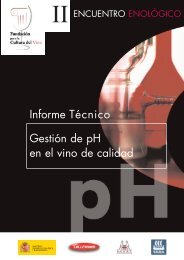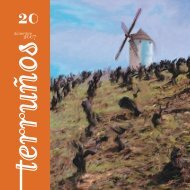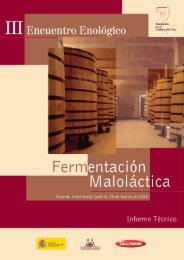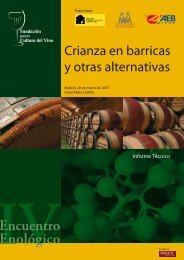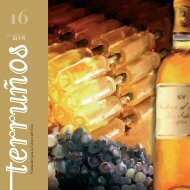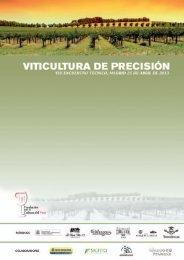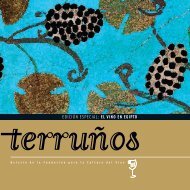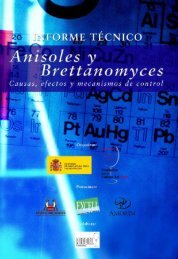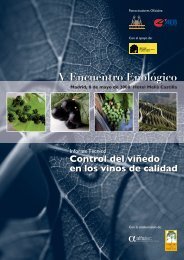Compuestos azufrados volátiles en vinos - Fundación para la ...
Compuestos azufrados volátiles en vinos - Fundación para la ...
Compuestos azufrados volátiles en vinos - Fundación para la ...
You also want an ePaper? Increase the reach of your titles
YUMPU automatically turns print PDFs into web optimized ePapers that Google loves.
Unravelling theg<strong>en</strong>etic blueprint ofwine yeastBorneman, A.R.; Forgan, A.H.; Chambers, P.J.; and Pretorius,I.S.The Australian Wine Research Institute, PO Box 197, Gl<strong>en</strong>Osmond (Ade<strong>la</strong>ide), South Australia 5064, AustraliaIn a world first, sci<strong>en</strong>tists at the Australian Wine ResearchInstitute have sequ<strong>en</strong>ced the wine yeast g<strong>en</strong>ome,characterising the ‘recipes of life’ that shapethis winemaker’s ‘fri<strong>en</strong>d’.Unlocking the secret to what makes wine yeast tickwill put winemakers in a stronger position to usesci<strong>en</strong>ce to their advantage. This work paves the wayfor the developm<strong>en</strong>t of new yeast strains, pot<strong>en</strong>tiallyleading to innovative solutions to tackle stuckferm<strong>en</strong>tation and to create wines with desired alcohollevels and f<strong>la</strong>vour profiles.Every four years, the Olympic Games inspire the worldwith spectacu<strong>la</strong>r performances and feats of <strong>en</strong>durance,speed and grace. We marvel at the athletic performanceof the competitors; most of us can only wonderhow these champions reach the standards theydo. What makes world record-breakers so profoundlydiffer<strong>en</strong>t to the rest of us? Are we not the same species,and therefore shouldn’t we all have the samepot<strong>en</strong>tial? Couldn’t we also win gold in swimming orrunning if we had the same training regimes, diet, lifestyle,etc.? The answer is no. Elite athletes are bornwith a pot<strong>en</strong>tial that has ‘gold’ stamped all over it. Theyhave muscle-types, physique, physiology and aptitudethat, with training, can be honed for internationalsuccess. Unfortunately, most of us would require agreat deal more than honing to reach this elite level;until bionics is able to rebuild what we are born with,wh<strong>en</strong> it comes to athletics, most humans will have tosettle for amateur league or less (Figure 1(a)).Differ<strong>en</strong>ces in performance of individuals of the samespecies are not peculiar to humans; in fact we see iteverywhere in nature. Take, for example, the humbleyeast that winemakers use to craft complex, deliciouswine from sweet, syrupy grape juice. Most wine yeastare the same species, Saccharomyces cere visiae, butnot all members of this group are able to producewine, and, among those that do, there is considerablevariation in how reliably and effici<strong>en</strong>tly they work, andin the quality of the wine they produce.Seminario Técnico<strong>Compuestos</strong> <strong>azufrados</strong> volátiles <strong>en</strong> <strong>vinos</strong>This begs the question: What makes a wine yeast tick?What, in the inner workings of this elite athlete, <strong>en</strong>ablesit to grow in such an inhospitable <strong>en</strong>vironm<strong>en</strong>t and delivergold medal wines wh<strong>en</strong> other S. cerevisiae strainsdon’t ev<strong>en</strong> leave the starting blocks? Research at theAustralian Wine Research Institute (AWRI) is beginningto unravel the mysteries of the variation across the S.cerevisiae species, and early results on what they tellus about wine yeast are tantalising.The variation in performance that we see across strainsof S. cerevisiae is inheritable; this means that it isg<strong>en</strong>etically determined. The starting point for characterisingthis variation, therefore, should focus on yeastg<strong>en</strong>etics.Fortunately, S. cerevisiae was the first organism of itstype to have its g<strong>en</strong>etic make-up (its g<strong>en</strong>ome) sequ<strong>en</strong>ced,and this was done over t<strong>en</strong> years ago on a strain,known as S288c, chos<strong>en</strong> for its ‘<strong>la</strong>boratory fri<strong>en</strong>dly’characteristics (for more information on what g<strong>en</strong>esand g<strong>en</strong>omes are, see the breakout box). Sci<strong>en</strong>tistslove this yeast because it is very easy to work with, butit would not win any medals in the winemaking ar<strong>en</strong>a;in fact, it is probably not ev<strong>en</strong> up to amateur status.Nevertheless, if you want to find out what makes wineyeast so differ<strong>en</strong>t from other S. cerevisiae strains, youhave to have something to compare it with, and S288cis a good starting point.Another strain of S. cerevisiae, YJM789, rec<strong>en</strong>tly hadits g<strong>en</strong>ome sequ<strong>en</strong>ced. The g<strong>en</strong>ome of this yeast, anopportunistic pathog<strong>en</strong> iso<strong>la</strong>ted from the lungs of anAIDS pati<strong>en</strong>t, turned out to be quite differ<strong>en</strong>t to thatS288c. Thus we had two differ<strong>en</strong>t versions of S. cerevisiaeto compare a wine yeast against, and this is whatwe found.It turns out that our wine yeast is a little more differ<strong>en</strong>tto the two previously sequ<strong>en</strong>ced strains than they areto each other (Figure 2). About 0.6% of the letters ofthe wine yeast sequ<strong>en</strong>ce are differ<strong>en</strong>t to what is foundin the <strong>la</strong>boratory strain. This might seem like a smalldiffer<strong>en</strong>ce, but if you consider that g<strong>en</strong>etic differ<strong>en</strong>cesbetwe<strong>en</strong> humans and chimpanzees amount to onlyabout 1-2%, it is really quite <strong>la</strong>rge.Perhaps of greater interest, however, is that thereare extra DNA sequ<strong>en</strong>ces in the wine yeast; <strong>en</strong>oughto carry at least 27 g<strong>en</strong>es that are not pres<strong>en</strong>t in thetwo yeasts it was compared against. In fact, some ofthe sequ<strong>en</strong>ces in this extra DNA do not resemble anythingfound in other species of Saccharomyces; theyappear to be more like g<strong>en</strong>es found in very distantfungal re<strong>la</strong>tives. We do not yet know how they gotinto the wine yeast g<strong>en</strong>ome, but we are curious tofind out whether or not they p<strong>la</strong>y a part in distinguishingwine yeast from other S. cerevisiae, particu<strong>la</strong>rly inthe winemaking stakes.Some of the wine yeast-specific g<strong>en</strong>es <strong>en</strong>code proteinsthat are probably associated with the cell wall,Textos asociadosWine Industry Journal > Vol 23 No 5 > September /October 200873



